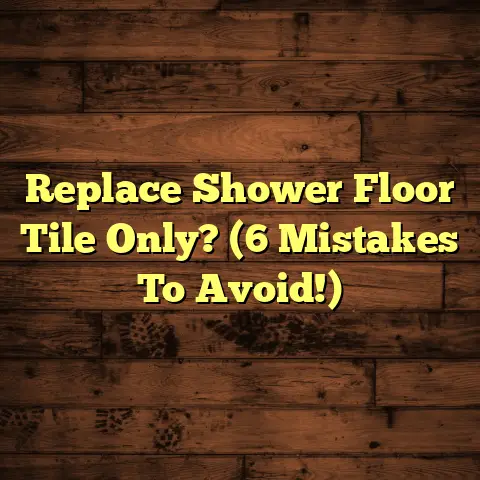Empire Vinyl Plank Flooring Cost (Explained)
When embarking on a flooring project, understanding the costs associated with materials and installation is crucial for making informed decisions. This comprehensive guide will delve into the various factors that impact the cost of Empire vinyl plank flooring, compare it with other flooring options, and provide essential insights to help you navigate your flooring journey.
Overview of Cost Factors
1. Area Size
The size of the area being covered is one of the most significant factors influencing the total cost of flooring installation. Larger spaces require more materials and potentially more labor, which can increase costs. Here are some considerations regarding area size:
- Measurement: Accurately measuring the space is critical. Measure the length and width of the room to determine the square footage. This will help you calculate how much material you will need.
- Room Shape: If the room has an irregular shape, additional calculations may be necessary to account for corners and alcoves. It might also require more precise cutting and fitting during installation, which can increase labor costs.
- Multiple Rooms: If you are installing flooring in multiple rooms, consider whether you want a consistent look throughout or different styles in each space. A uniform choice can sometimes reduce costs through bulk purchasing.
2. Type of Vinyl Plank
Empire offers a variety of vinyl plank flooring options, including luxury vinyl tile (LVT) and standard vinyl planks. Each type has different price points based on quality, design, and durability.
- Standard Vinyl Plank: Generally more affordable, standard vinyl planks range from $2 to $4 per square foot. They are suitable for low-traffic areas and come in various designs to mimic natural materials.
- Luxury Vinyl Plank (LVP): Higher quality and more durable than standard vinyl planks, LVP ranges from $4 to $7 per square foot. These planks often feature advanced designs that closely resemble hardwood or stone, making them ideal for high-traffic areas or those wanting a more upscale appearance.
3. Labor Costs
Labor costs can vary significantly based on location, complexity of the installation, and the contractor’s experience. Here are some details to consider:
- Geographic Location: Labor rates fluctuate based on your region. Urban areas typically have higher rates than rural locations due to demand and living costs.
- Experience Level: Hiring an experienced contractor may carry a higher initial cost but can save money in the long run by ensuring quality installation that prevents future issues.
- Installation Complexity: If your project involves intricate designs or custom layouts, such as herringbone or diagonal patterns, expect labor costs to increase due to the additional time and skill required.
4. Additional Considerations
Several additional factors can impact the overall cost of your Empire vinyl plank flooring project:
Floor Removal
If you need to remove existing flooring before installing new vinyl planks, this can add significantly to labor costs. Here’s what to consider:
- Type of Existing Flooring: The removal process varies depending on whether you’re dealing with carpet, tile, laminate, or hardwood. Each type requires different tools and techniques.
- Disposal Fees: Some contractors charge extra for disposing of old flooring materials—be sure to ask about this when getting estimates.
Subfloor Replacement
In some cases, the subfloor may need repair or replacement before new flooring can be installed:
- Assessing the Subfloor: A thorough inspection is necessary to check for damage or moisture issues that could affect the new flooring’s performance.
- Material Costs: Depending on the extent of repairs needed, additional materials such as plywood or underlayment may be required, adding to your overall budget.
Material Grade
Higher-grade materials typically come at a premium. Here’s why this matters:
- Durability and Warranty: Investing in higher-quality vinyl planks often means better durability and longer warranties, which can save you money in repairs or replacements over time.
- Appearance: Higher-grade materials often feature better finishes and more realistic designs, enhancing the overall aesthetic appeal of your space.
Room Size/Layout
The size and layout of your room can significantly impact installation time and costs:
- Open Floor Plans: Large, open spaces may be easier and quicker to install than smaller rooms with many corners and transitions.
- Complex Layouts: Rooms with numerous alcoves, angles, or fixtures may require more precise cutting and fitting, increasing labor costs.
Installation Type
The method used for installing vinyl planks can affect both material and labor costs:
- Floating Installation: This popular method involves laying planks without glue or nails, making it relatively easy for DIY enthusiasts. It can cost less in terms of labor but still requires a proper underlayment for moisture protection.
- Glue-Down Installation: More time-consuming than floating installations, this method can provide added stability but may result in higher labor costs due to the extra time needed for glue application and drying.
Detailed Cost Breakdown
Price Ranges for Empire Vinyl Plank Flooring
Understanding the price ranges for different types of vinyl plank flooring is essential for budgeting:
Material Costs
| Type | Price Range ($/sq. ft.) |
|---|---|
| Standard Vinyl Plank | $2 – $4 |
| Luxury Vinyl Plank (LVP) | $4 – $7 |
Installation Costs
| Installation Method | Price Range ($/sq. ft.) |
|---|---|
| DIY Installation | Free – $0.50 |
| Professional Installation | $1 – $3 |
Example Cost Scenarios
Let’s break down total costs for various project sizes to give you a clearer picture of potential expenses:
Small Room (100 sq. ft.)
- Material (LVP):
- Price: $4/sq. ft.
- Total: $400
- Installation (Professional):
- Price: $2/sq. ft.
- Total: $200
- Total Cost:
- $600
Medium Room (500 sq. ft.)
- Material (LVP):
- Price: $4/sq. ft.
- Total: $2,000
- Installation (Professional):
- Price: $2/sq. ft.
- Total: $1,000
- Total Cost:
- $3,000
Large Room (1,000 sq. ft.)
- Material (LVP):
- Price: $4/sq. ft.
- Total: $4,000
- Installation (Professional):
- Price: $2/sq. ft.
- Total: $2,000
- Total Cost:
- $6,000
Comparison with Other Flooring Options
When considering Empire vinyl plank flooring, it’s essential to compare it with other flooring options like hardwood, laminate, and carpet in terms of cost and performance.
Hardwood Flooring Costs
Hardwood flooring is renowned for its beauty and durability but comes with a higher price tag:
| Flooring Type | Material Cost ($/sq. ft.) | Installation Cost ($/sq. ft.) | Total Estimated Cost (1000 sq. ft.) |
|---|---|---|---|
| Hardwood | $5 – $10 | $2 – $5 | $7,000 – $15,000 |
Laminate Flooring Costs
Laminate flooring is generally a budget-friendly alternative to both hardwood and vinyl planks:
| Flooring Type | Material Cost ($/sq. ft.) | Installation Cost ($/sq. ft.) | Total Estimated Cost (1000 sq. ft.) |
|---|---|---|---|
| Laminate | $1 – $3 | $1 – $2 | $2,000 – $5,000 |
Carpet Costs
Carpet is another common option that varies in price based on material type and style:
| Flooring Type | Material Cost ($/sq. ft.) | Installation Cost ($/sq. ft.) | Total Estimated Cost (1000 sq. ft.) |
|---|---|---|---|
| Carpet | $2 – $5 | $1 – $2 | $3,000 – $7,000 |
Summary Comparison Chart
Here’s a summary comparison chart for quick reference:
| Flooring Type | Material Cost Range ($/sq. ft.) | Installation Cost Range ($/sq. ft.) | Total Estimated Cost (1000 sq. ft.) |
|---|---|---|---|
| Empire Vinyl Plank | $2 – $7 | $1 – $3 | $3,000 – $10,000 |
| Hardwood | $5 – $10 | $2 – $5 | $7,000 – $15,000 |
| Laminate | $1 – $3 | $1 – $2 | $2,000 – $5,000 |
| Carpet | $2 – $5 | $1 – $2 | $3,000 – $7,000 |
Signs That Hardwood Floors Need Replacement
While this article focuses primarily on vinyl options, it’s important to recognize when hardwood floors may need replacement versus refinishing:
- Severe Scratches and Dents: If your floor has deep scratches that cannot be sanded out or refinished successfully.
- Water Damage: Constant exposure to water can lead to warping or buckling that makes refinishing ineffective.
- Excessive Cupping or Crowning: Changes in wood shape indicate underlying structural issues that may necessitate replacement.
- Persistent Odours: A musty smell often indicates moisture problems beneath the floor that could compromise integrity.
- Visible Gaps: Significant gaps between planks signal that replacement may be necessary for proper aesthetics and functionality.
Refinishing vs. Replacement
When deciding whether to refinish or replace hardwood floors, consider these factors:
Refinishing
Refinishing is best suited for floors with minor wear and tear; it restores their original beauty without the higher costs associated with full replacement:
- Cost-Effective: Typically costs less than replacing entire floors.
- Time-Saving: Refinishing takes less time than full replacement since it usually involves sanding down existing finishes rather than removing all materials.
Replacement
Replacement becomes necessary when floors exhibit substantial damage that refinishing cannot remedy:
- Extensive Damage: Water damage or significant warping often requires new materials.
- Outdated Style: If you’re looking to upgrade your flooring style entirely rather than just restoring what you have.
Pros and Cons of Hardwood Flooring
While this article primarily discusses vinyl plank options, understanding the pros and cons of hardwood flooring helps in making informed choices based on your needs:
Pros
- Aesthetic Appeal: Hardwood floors offer timeless beauty that enhances any home’s interior design.
- Durability: With proper care, hardwood floors can last decades or even a lifetime.
- Increased Home Value: Quality hardwood flooring increases property value significantly compared to alternative options.
Cons
- Cost: Initial investment for hardwood is typically higher than vinyl or laminate alternatives.
- Maintenance: Requires regular upkeep including cleaning and occasional refinishing.
- Susceptibility to Moisture: Prone to water damage if not properly sealed or maintained.
Professional Installation vs. DIY
Cost Differences
Assessing whether to hire professionals or take the DIY route can significantly affect overall costs:
- Professional Installation: Hiring experts ensures a high-quality finish but comes at a higher price due to labor costs ranging from $1 to $3 per square foot.
- DIY Installation: Allows homeowners to save on labor costs but requires tools and skills; improper installation can lead to future issues that negate initial savings.
Tools Needed for DIY Installation
If you decide on a DIY installation approach for vinyl planks, be prepared with essential tools:
- Measuring Tape: Accurate measurements are critical.
- Utility Knife: For cutting planks accurately.
- Tapping Block & Pull Bar: Helps ensure snug fits between planks.
- Spacers: Maintain necessary expansion gaps around edges.
- Leveling Tool: Ensures an even surface before installation begins.
- Underlayment (if necessary): Provides cushioning and moisture protection depending on subfloor conditions.
Questions to Ask Hardwood Flooring Contractors
If you opt for professional assistance, asking the right questions is vital in selecting a qualified contractor:
- What types of flooring do you recommend for my specific needs?
- Can you provide a detailed estimate that includes all potential costs?
- How long will it take to complete the installation?
- What is included in your warranty?
- Are there any additional costs I should be aware of?
- Do you have references from previous clients I can contact?
- What steps do you take to ensure a clean job site?
Care and Maintenance Tips for Hardwood Floors
To maximize your hardwood floors’ longevity—whether newly installed or recently refinished—consider these care tips:
- Regular Cleaning: Use a broom or vacuum specifically designed for hardwood floors; avoid harsh chemicals that may damage finishes.
- Avoid Excess Moisture: Wipe up spills immediately to prevent water damage; use mats or rugs in areas prone to moisture exposure.
- Use Rugs and Mats: Place them at entryways to reduce dirt and debris on floors; this protects against scratches and wear.
- Refinish Periodically: Depending on wear patterns, refinishing every 5–10 years keeps floors looking new; consult professionals about timing.
- Maintain Humidity Levels: Keep indoor humidity between 30% and 50%—too much moisture can warp floors while too little can cause cracks.
Conclusion
Understanding the costs associated with Empire vinyl plank flooring is essential in making informed decisions about your flooring project. By considering all factors—from material choice to installation methods—you can create a beautiful and durable floor that meets your needs without breaking the bank.
This comprehensive guide has explored various cost factors related to Empire vinyl plank flooring alongside comparisons with alternative options like hardwood, laminate, and carpet.
By being well-informed about your choices—whether investing in luxury vinyl planks or considering traditional hardwood—you’ll make decisions that enhance both your home’s aesthetic appeal and functionality while staying within budget.
If you have further questions or require specific estimates based on your project scope—don’t hesitate to reach out! Your dream floor is just a decision away!





